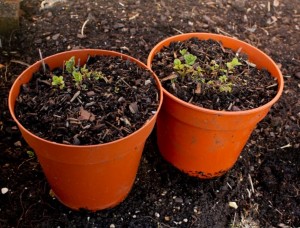 Sowing times on seed packets can largely be ignored in spring. One example is the instruction ‘direct sow from February onwards’ on parsnip seed packets. The key to successful germination are constant soil temperatures – that’s when a soil thermometer becomes invaluable. Sow when it is too cold and the seed simply sits in the soil; when germination does occur it is erratic and worst of all the seed may simply rot. It is better to know that parsnips need a soil temperatures around 6 C (42F) to germinate and sowing is better delayed until April or May without any adverse effects on cropping. Cabbage, peas and beans need a minimum of 5 C(41F), leeks and onions, 7C(44F) and those with origins in warmer parts of the world, like cucumbers need at least 13 C (55F). Even potatoes have a temperature requirement of 6C (43F) at 4” (10cm), their planting depth at least three days before planting. The best way to beat the weather is to sow crops in trays and modules for transplanting later in the season and gain growing time. Plants that dislike transplanting, like parsley and carrots, can be sown in small pots or modules and then carefully transplanted into the vegetable garden without disturbing the roots. The answer overall is to be patient, seeds will germinate quickly, once the soil is warm and soon catch up or beat the weather and sow under cover and transplant. I usually start by germinating under glass, then sow the next batch outdoors. Sowing marrows, courgettes, squashes, cucumbers and pumpkins should be timed to miss the last frosts. Sow two seeds on edge in 31/2” pots (sowing on edge means they are less prone to rotting) then remove the weakest seedling. They can be potted on into 5” pots and grown on until the weather is warm enough for them to be ‘hardened off’ and planted out. Sow sweetcorn at one seed per cell, burying the seed at its own depth in multipurpose compost. Plant out when they are 3-5” (7.5-12.5cm) tall if the soil is warm enough, if not, repot, then grow on in the glasshouse. Don’t plant them outdoors too early, they need warmth to grow.
Sowing times on seed packets can largely be ignored in spring. One example is the instruction ‘direct sow from February onwards’ on parsnip seed packets. The key to successful germination are constant soil temperatures – that’s when a soil thermometer becomes invaluable. Sow when it is too cold and the seed simply sits in the soil; when germination does occur it is erratic and worst of all the seed may simply rot. It is better to know that parsnips need a soil temperatures around 6 C (42F) to germinate and sowing is better delayed until April or May without any adverse effects on cropping. Cabbage, peas and beans need a minimum of 5 C(41F), leeks and onions, 7C(44F) and those with origins in warmer parts of the world, like cucumbers need at least 13 C (55F). Even potatoes have a temperature requirement of 6C (43F) at 4” (10cm), their planting depth at least three days before planting. The best way to beat the weather is to sow crops in trays and modules for transplanting later in the season and gain growing time. Plants that dislike transplanting, like parsley and carrots, can be sown in small pots or modules and then carefully transplanted into the vegetable garden without disturbing the roots. The answer overall is to be patient, seeds will germinate quickly, once the soil is warm and soon catch up or beat the weather and sow under cover and transplant. I usually start by germinating under glass, then sow the next batch outdoors. Sowing marrows, courgettes, squashes, cucumbers and pumpkins should be timed to miss the last frosts. Sow two seeds on edge in 31/2” pots (sowing on edge means they are less prone to rotting) then remove the weakest seedling. They can be potted on into 5” pots and grown on until the weather is warm enough for them to be ‘hardened off’ and planted out. Sow sweetcorn at one seed per cell, burying the seed at its own depth in multipurpose compost. Plant out when they are 3-5” (7.5-12.5cm) tall if the soil is warm enough, if not, repot, then grow on in the glasshouse. Don’t plant them outdoors too early, they need warmth to grow.
April is the ideal time to divide bamboos and grasses. Push two forks back to back into the centre of the clump then prise it apart. Alternatively, chop the plant into several sections with an old spade. Old material from the centre of the clump can be composted, the soil improved with the addition of grit and well rotted compost if necessary and the new divisions replanted or exchanged with friends. Early in the month is a good time to divide potted herbs, too. I split a clump of Moroccan Mint, to maintain the vigour (see image). Plant divisions of thyme and French Tarragon and other plants that thrive in Mediterranean conditions into John Innes no1 compost with 20% added grit and other moisture loving herbs like mint into a mixture of John Innes no. 2 and multipurpose compost. Water well after transplanting. There is plenty to do, so go out and enjoy it!
Happy Gardening. Matt










